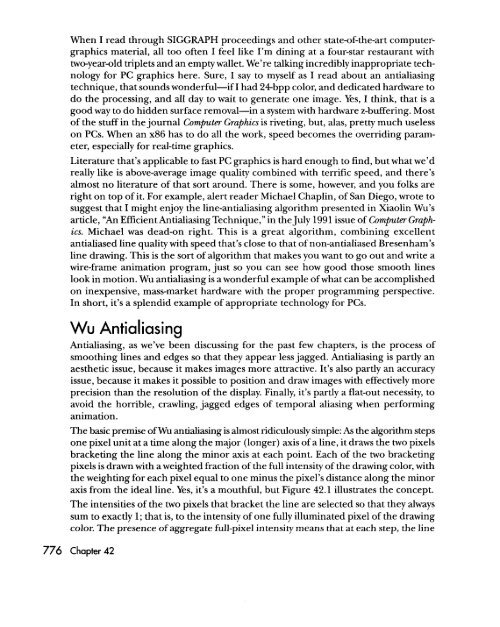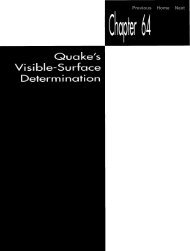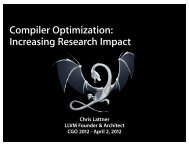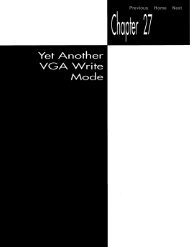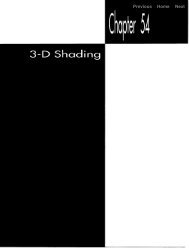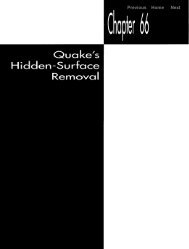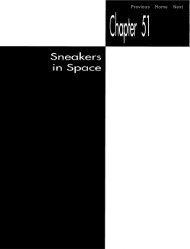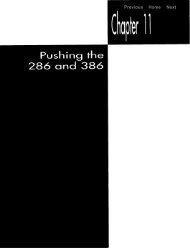wu'ed in haste; fried, stewed at leisure
wu'ed in haste; fried, stewed at leisure
wu'ed in haste; fried, stewed at leisure
You also want an ePaper? Increase the reach of your titles
YUMPU automatically turns print PDFs into web optimized ePapers that Google loves.
When I read through SIGGRAPH proceed<strong>in</strong>gs and other st<strong>at</strong>e-of-the-art computergraphicsm<strong>at</strong>erial, all too often I feel like I’m d<strong>in</strong><strong>in</strong>g <strong>at</strong> a four-star restaurant withtwo-year-old triplets and an empty wallet. We’re talk<strong>in</strong>g <strong>in</strong>credibly <strong>in</strong>appropri<strong>at</strong>e technologyfor PC graphics here. Sure, I say to myself as I read about an antialias<strong>in</strong>gtechnique, th<strong>at</strong> sounds wonderful-if I had 24bpp color, and dedic<strong>at</strong>ed hardware todo the process<strong>in</strong>g, and all day to wait to gener<strong>at</strong>e one image. Yes, I th<strong>in</strong>k, th<strong>at</strong> is agood way to do hidden surface removal-<strong>in</strong> a system with hardware z-buffer<strong>in</strong>g. Mostof the stuff <strong>in</strong> the journal Computer Ofaphics is rivet<strong>in</strong>g, but, alas, pretty much uselesson PCs. When an x86 has to do all the work, speed becomes the overrid<strong>in</strong>g parameter,especially for real-time graphics.Liter<strong>at</strong>ure th<strong>at</strong>’s applicable to fast PC graphics is hard enough to f<strong>in</strong>d, but wh<strong>at</strong> we’dreally like is above-average image quality comb<strong>in</strong>ed with terrific speed, and there’salmost no liter<strong>at</strong>ure of th<strong>at</strong> sort around. There is some, however, and you folks areright on top of it. For example, alert reader Michael Chapl<strong>in</strong>, of San Diego, wrote tosuggest th<strong>at</strong> I might enjoy the l<strong>in</strong>e-antialias<strong>in</strong>g algorithm presented <strong>in</strong> Xiaol<strong>in</strong> Wu’sarticle, “An Efficient Antialias<strong>in</strong>g Technique,” <strong>in</strong> the July 1991 issue of Computer Guphics.Michael was dead-on right. This is a gre<strong>at</strong> algorithm, comb<strong>in</strong><strong>in</strong>g excellentantialiased l<strong>in</strong>e qualitywith speed th<strong>at</strong>’s close to th<strong>at</strong> of non-antialiased Bresenham’sl<strong>in</strong>e draw<strong>in</strong>g. This is the sort of algorithm th<strong>at</strong> makes you want to go out and write awire-frame anim<strong>at</strong>ion program, just so you can see how good those smooth l<strong>in</strong>eslook <strong>in</strong> motion. Wu antialias<strong>in</strong>g is a wonderful example of wh<strong>at</strong> can be accomplishedon <strong>in</strong>expensive, mass-market hardware with the proper programm<strong>in</strong>g perspective.In short, it’s a splendid example of appropri<strong>at</strong>e technology for PCs.Wu Antialias<strong>in</strong>gAntialias<strong>in</strong>g, as we’ve been discuss<strong>in</strong>g for the past few chapters, is the process ofsmooth<strong>in</strong>g l<strong>in</strong>es and edges so th<strong>at</strong> they appear less jagged. Antialias<strong>in</strong>g is partly anaesthetic issue, because it makes images more <strong>at</strong>tractive. It’s also partly an accuracyissue, because it makes it possible to position and draw images with effectively moreprecision than the resolution of the display. F<strong>in</strong>ally, it’s partly a fl<strong>at</strong>-out necessity, toavoid the horrible, crawl<strong>in</strong>g, jagged edges of temporal alias<strong>in</strong>g when perform<strong>in</strong>ganim<strong>at</strong>ion.The basic premise of Wu antialias<strong>in</strong>g is almost ridiculously simple: As the algorithm stepsone pixel unit <strong>at</strong> a time along the major (longer) axis of a l<strong>in</strong>e, draws it the two pixelsbracket<strong>in</strong>g the l<strong>in</strong>e along the m<strong>in</strong>or axis <strong>at</strong> each po<strong>in</strong>t. Each of the two bracket<strong>in</strong>gpixels is drawn with a weighted fraction of the full <strong>in</strong>tensity of the draw<strong>in</strong>g color, withthe weight<strong>in</strong>g for each pixel equal to one m<strong>in</strong>us the pixel’s distance along the m<strong>in</strong>oraxis from the ideal l<strong>in</strong>e. Yes, it’s a mouthful, but Figure 42.1 illustr<strong>at</strong>es the concept.The <strong>in</strong>tensities of the two pixels th<strong>at</strong> bracket the l<strong>in</strong>e are selected so th<strong>at</strong> they alwayssum to exactly 1; th<strong>at</strong> is, to the <strong>in</strong>tensity of one fully illum<strong>in</strong><strong>at</strong>ed pixel of the draw<strong>in</strong>gcolor. The presence of aggreg<strong>at</strong>e full-pixel <strong>in</strong>tensity means th<strong>at</strong> <strong>at</strong> each step, the l<strong>in</strong>e776 Chapter 42


